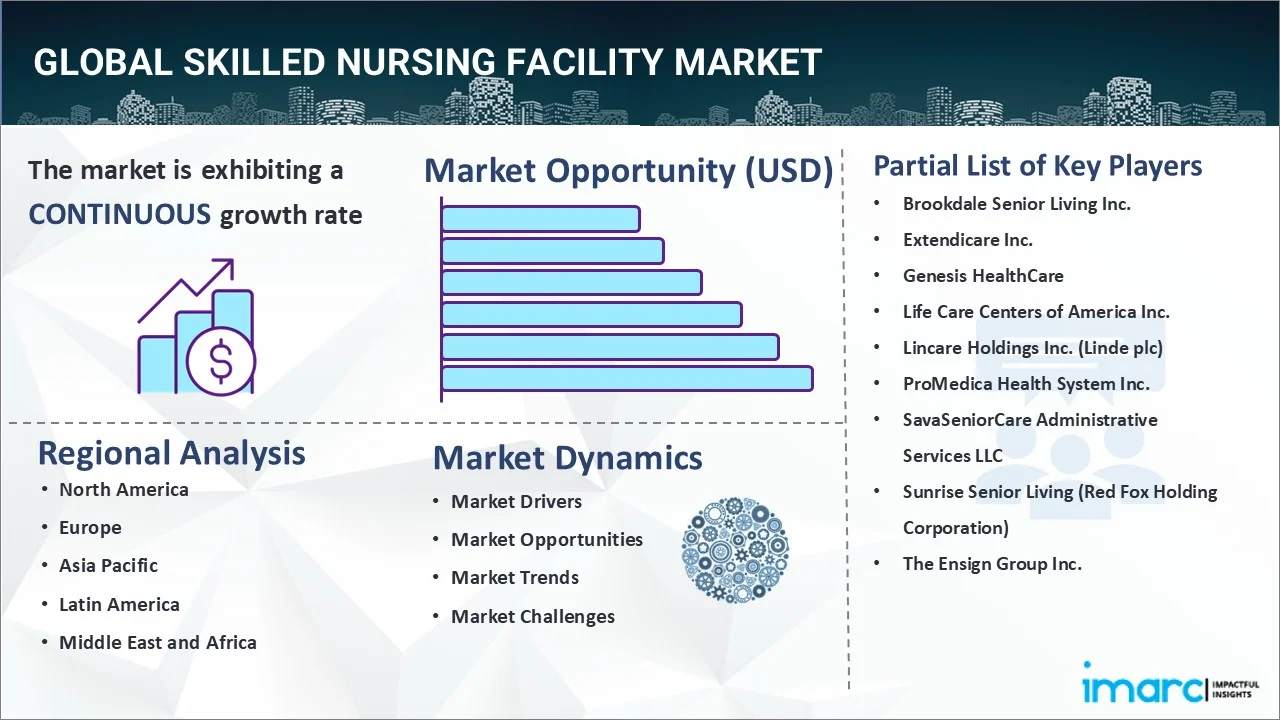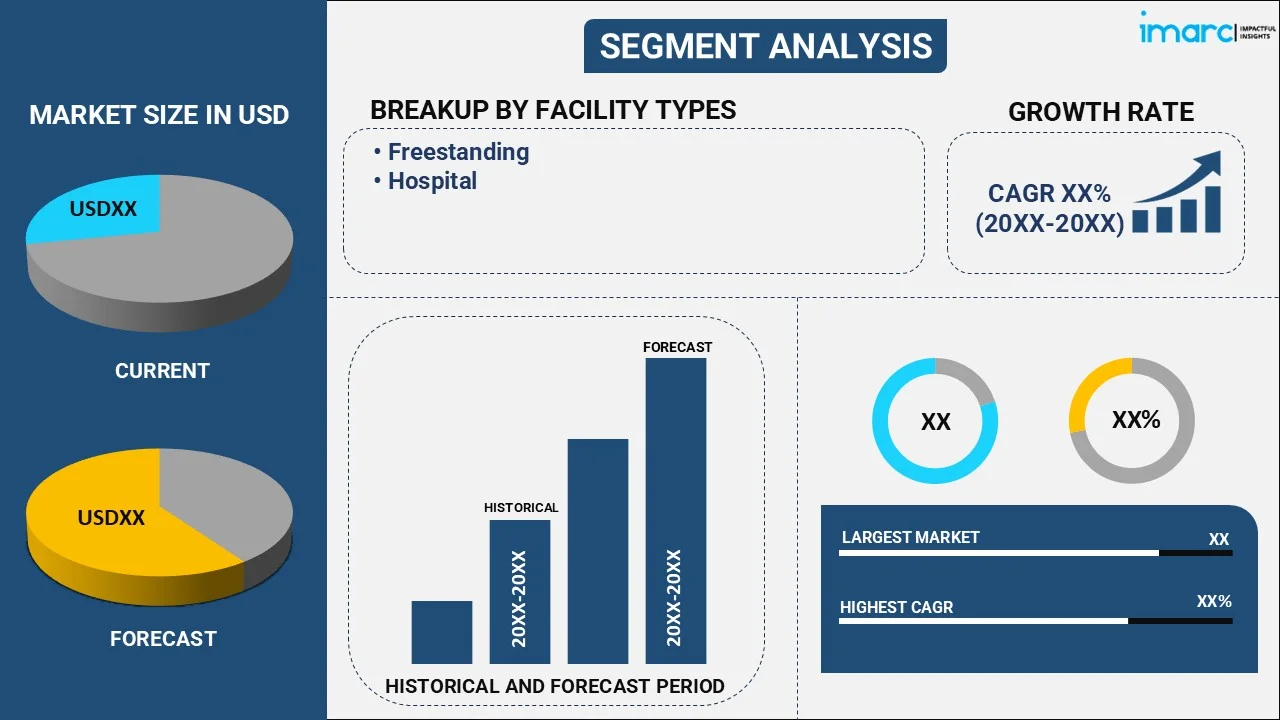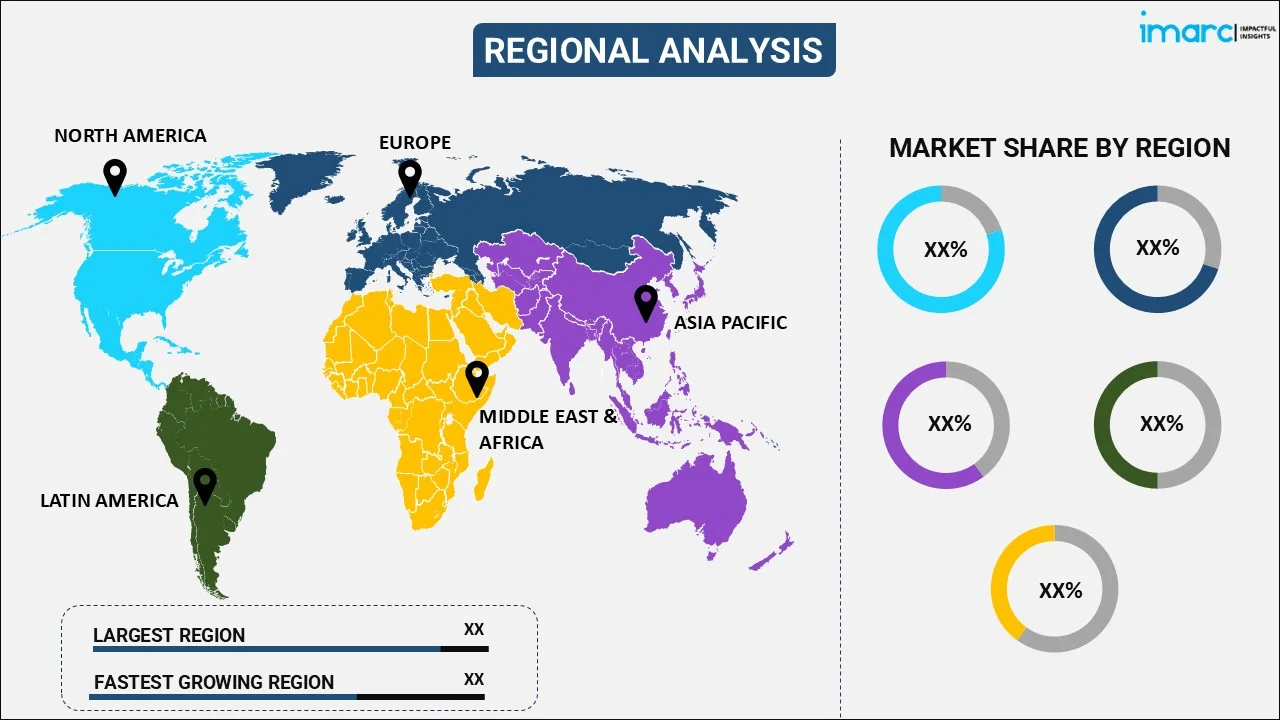
Skilled Nursing Facility Market by Facility Type (Freestanding, Hospital), Service Type (Intensive Rehabilitation Therapy, Low and Medium Rehabilitation, Medically Complex), Ownership Type (Non-Profit, For-Profit, Government), and Region 2025-2033
Skilled Nursing Facility Market Size:
The global skilled nursing facility market size reached USD 377.5 Billion in 2024. Looking forward, IMARC Group expects the market to reach USD 655.2 Billion by 2033, exhibiting a growth rate (CAGR) of 6.32% during 2025-2033. The growing geriatric population, increasing prevalence of chronic diseases, rising demand for long-term care, ongoing advancements in healthcare technology, and a shift towards home-like care environments are some of the key factors contributing to the market growth.
|
Report Attribute
|
Key Statistics |
|---|---|
|
Base Year
|
2024
|
|
Forecast Years
|
2025-2033
|
|
Historical Years
|
2019-2024
|
|
Market Size in 2024
|
USD 377.5 Billion |
|
Market Forecast in 2033
|
USD 655.2 Billion |
| Market Growth Rate (2025-2033) | 6.32% |
Skilled Nursing Facility Market Analysis:
- Major Market Drivers: The aging population and rising prevalence of chronic diseases significantly drive the demand for skilled nursing facilities (SNFs), as older adults require long-term, specialized care. Additionally, ongoing technological advancements, including electronic health records (EHRs) and telemedicine, enhance care delivery and operational efficiency, thus strengthening the market growth.
- Key Market Trends: The rising demand for intensive rehabilitation therapy focusing on high-frequency, goal-oriented care due to its critical role in recovering patients with severe injuries or conditions is one of the main trends fostering market expansion. Along with this, the widespread move toward more personalized, homelike environments that enhance resident satisfaction and quality of life is further boosting the demand for SNFs.
- Geographical Trends: Based on the skilled nursing facility industry report, North America leads the market due to a robust healthcare infrastructure, significant investments in long-term care, and a substantial aging population. In addition to this, the rise in the proliferation of for-profit SNFs in North America, benefiting from their ability to invest in advanced facilities and competitive service offerings is impelling the market growth.
- Competitive Landscape: Some of the major market players in the skilled nursing facility industry include Brookdale Senior Living Inc., Extendicare Inc., Genesis HealthCare, Life Care Centers of America Inc., Lincare Holdings Inc. (Linde plc), ProMedica Health System Inc., SavaSeniorCare Administrative Services LLC, Sunrise Senior Living (Red Fox Holding Corporation), The Ensign Group Inc., among many others.
- Challenges and Opportunities: Managing operating expenses, adhering to regulations, and competing with alternative care models like assisted living and home health care are some of the constraints in the market. Meanwhile, the opportunities lie in leveraging technological advancements, expanding specialized care services, and enhancing facility environments to meet evolving patient expectations and market demands.

To get more information on this market, Request Sample
Skilled Nursing Facility Market Trends:
Aging population and rising chronic disease prevalence:
One of the prominent trends influencing market growth is the rising chronic diseases and increasing aging population. As the baby boomer generation continues to age, the demand for skilled nursing services is rising. Moreover, a higher prevalence of age-related health issues, such as dementia, arthritis, and cardiovascular diseases, which call for specialized long-term care, is providing an impetus to the market growth. According to the U.S. Census Bureau, the number of individuals aged 65 and older is expected to double by 2060, reaching approximately 98 million. This has heightened the need for SNFs that can provide medical attention, rehabilitation, and individualized support for the elderly. Additionally, the rising prevalence of chronic diseases among older adults exacerbates the need for continuous and comprehensive care, further bolstering the skilled nursing facility demand.
Advancements in healthcare technology:
Innovations such as EHRs, telemedicine, and advanced diagnostic tools are transforming how care is delivered within these facilities. EHRs enhance the efficiency and accuracy of patient data management, enabling better coordination of care and improved clinical outcomes. Telemedicine allows for remote consultations with specialists, reducing the need for transportation and providing access to a broader range of medical expertise. Additionally, the real-time tracking of patients' health metrics made possible by the integration of wearable health technologies and remote monitoring systems results in prompt interventions and individualized care plans. These technological advancements improve the quality of care and optimize operational efficiency and resource management, supporting the skilled nursing facility market growth.
Shift toward home-like care environments:
A wider shift in patient preferences and expectations creating homelike care environments in SNFs is acting as another significant growth-inducing factor. Modern SNFs are increasingly designed to resemble residential settings rather than traditional institutional environments. The desire for a more welcoming, customized, and encouraging environment that improves residents' quality of life is bolstering the market growth. Features, such as private rooms, communal living spaces, and personalized care plans are becoming standard as facilities aim to provide a more homely and less clinical experience. Moreover, research demonstrating that a more homelike setting can enhance residents' satisfaction, lessen feelings of loneliness, and foster greater mental and emotional well-being are also positively impacting the skilled nursing facility industry outlook.
Skilled Nursing Facility Market Segmentation:
IMARC Group provides an analysis of the key trends in each segment of the market, along with forecasts at the global, regional, and country levels for 2025-2033. Our report has categorized the market based on facility type, service type, and ownership type.
Breakup by Facility Type:

- Freestanding
- Hospital
Freestanding accounts for the majority of the market share
The report has provided a detailed breakup and analysis of the market based on the facility type. This includes freestanding and hospital. According to the report, freestanding represented the largest segment.
Based on the skilled nursing facility market research report, freestanding dominates the market due to its independent operations and specialized focus on providing comprehensive care. With their exclusive focus on long-term care, freestanding facilities, in contrast to hospital-based SNFs, are able to provide a broad range of services catered to the requirements of their residents. Their independence makes it possible to provide more individualized care, flexible in how it is delivered and creates a welcoming atmosphere for patients and their families. Along with this, freestanding SNFs often benefit from streamlined operations and specialized staff, enhancing care quality and operational efficiency. These factors contribute to consumer preference seeking dedicated, high-quality, long-term care solutions, thereby bolstering the skilled nursing facility market share.
Breakup by Service Type:
- Intensive Rehabilitation Therapy
- Low and Medium Rehabilitation
- Medically Complex
Intensive rehabilitation therapy holds the largest share of the industry
A detailed breakup and analysis of the market based on the service type have also been provided in the report. This includes intensive rehabilitation therapy, low and medium rehabilitation, and medically complex. According to the report, intensive rehabilitation therapy accounted for the largest market share.
With the increasing demand for intensive rehabilitation therapy due to its critical role in the recovery and improvement of patients with severe injuries or conditions, there is an increasing demand for SNFs. This therapy focuses on intensive, goal-oriented rehabilitation to enhance functional outcomes, often involving physical, occupational, and speech therapies. Patients recovering from surgeries, strokes, or traumatic injuries require comprehensive, high-frequency rehabilitation services to regain independence and quality of life. The effectiveness of intensive rehabilitation in achieving significant functional improvements drives its high demand and preference within skilled nursing facilities. This focus on intensive therapy ensures that patients receive the necessary support and personalized care, creating a favorable skilled nursing facility market outlook.
Breakup by Ownership Type:
- Non-Profit
- For-Profit
- Government
For-profit represents the leading market segment
The report has provided a detailed breakup and analysis of the market based on the ownership type. This includes non-profit, for-profit, and government. According to the report, for-profit represented the largest segment.
For-profit skilled nursing facilities represent the leading market segment due to their ability to invest in infrastructure, technology, and staff to enhance care quality and operational efficiency. These facilities operate with a focus on financial performance, which allows them to attract investment for facility upgrades and advanced healthcare technologies. Additionally, for-profit SNFs often implement innovative management practices and competitive pricing strategies to attract residents. Their business model enables them to offer a broad range of services and amenities, appealing to a wide demographic. The combination of financial resources, operational flexibility, and service quality helps for-profit facilities capture the largest skilled nursing facility market revenue and maintain a significant presence in this industry.
Breakup by Region:

- North America
- United States
- Canada
- Asia Pacific
- China
- Japan
- India
- South Korea
- Australia
- Indonesia
- Others
- Europe
- Germany
- France
- United Kingdom
- Italy
- Spain
- Others
- Latin America
- Brazil
- Mexico
- Others
- Middle East and Africa
North America leads the market, accounting for the largest skilled nursing facility market share
The report has also provided a comprehensive analysis of all the major regional markets, which include North America (the United States and Canada); Asia Pacific (China, Japan, India, South Korea, Australia, Indonesia, and others); Europe (Germany, France, the United Kingdom, Italy, Spain, and others); Latin America (Brazil, Mexico, and others); and the Middle East and Africa. According to the report, North America represents the largest regional market for skilled nursing facilities.
The skilled nursing facility market forecast highlights North America as a leading region owing to the well-established healthcare infrastructure, advanced medical technology, and significant investments in long-term care services. The aging population in North America, particularly in the U.S. and Canada, drives high demand for skilled nursing care, as these countries have some of the highest proportions of elderly individuals requiring specialized care. In addition to this, favorable government policies and funding for healthcare services combined with high standards for patient care and safety, contribute to North America's dominant market position.
Competitive Landscape:
- The market research report has also provided a comprehensive analysis of the competitive landscape in the market. Detailed profiles of all major companies have also been provided. Some of the major market players in the skilled nursing facility industry include Brookdale Senior Living Inc., Extendicare Inc., Genesis HealthCare, Life Care Centers of America Inc., Lincare Holdings Inc. (Linde plc), ProMedica Health System Inc., SavaSeniorCare Administrative Services LLC, Sunrise Senior Living (Red Fox Holding Corporation), The Ensign Group Inc., etc.
(Please note that this is only a partial list of the key players, and the complete list is provided in the report.)
- On the basis of the skilled nursing facility market insights, the competitive landscape is characterized by a diverse range of players, including large for-profit chains, non-profit organizations, and government-operated facilities. For-profit SNFs often lead the market due to their substantial resources, which enable them to invest in advanced technologies, facility upgrades, and specialized care services. Non-profit and government facilities focus on delivering community-centered care and may benefit from various funding and support programs. Competition is driven by factors such as service quality, facility amenities, cost-efficiency, and patient satisfaction. Operators differentiate themselves through specialized care programs, such as intensive rehabilitation and dementia care, and by creating homelike environments to attract residents. Along with this, regulatory compliance and accreditation standards play a crucial role in skilled nursing facility market dynamics and maintaining competitive advantage.
Skilled Nursing Facility Market News:
- In April 2024, SSM Health and Inbound Health partnered to offer personalized in-home post-hospital care, aiming to provide patients with an alternative to traditional skilled nursing facilities (SNFs).
- In September 2023, A Place for Mom launched Nursinghomes.com, expanding its services into the nursing home sector. This new platform aims to be a comprehensive resource for families, offering detailed information to evaluate and contact skilled nursing and long-term care facilities.
Skilled Nursing Facility Market Report Scope:
| Report Features | Details |
|---|---|
| Base Year of the Analysis | 2024 |
| Historical Period | 2019-2024 |
| Forecast Period | 2025-2033 |
| Units | Billion USD |
| Scope of the Report | Exploration of Historical Trends and Market Outlook, Industry Catalysts and Challenges, Segment-Wise Historical and Future Market Assessment:
|
| Facility Types Covered | Freestanding, Hospital |
| Service Types Covered | Intensive Rehabilitation Therapy, Low and Medium Rehabilitation, Medically Complex |
| Ownership Types Covered | Non-Profit, For-Profit, Government |
| Regions Covered | Asia Pacific, Europe, North America, Latin America, Middle East and Africa |
| Countries Covered | United States, Canada, Germany, France, United Kingdom, Italy, Spain, China, Japan, India, South Korea, Australia, Indonesia, Brazil, Mexico |
| Companies Covered | Brookdale Senior Living Inc., Extendicare Inc., Genesis HealthCare, Life Care Centers of America Inc., Lincare Holdings Inc. (Linde plc), ProMedica Health System Inc., SavaSeniorCare Administrative Services LLC, Sunrise Senior Living (Red Fox Holding Corporation), The Ensign Group Inc., etc. |
| Customization Scope | 10% Free Customization |
| Post-Sale Analyst Support | 10-12 Weeks |
| Delivery Format | PDF and Excel through Email (We can also provide the editable version of the report in PPT/Word format on special request) |
Key Benefits for Stakeholders:
- IMARC’s industry report offers a comprehensive quantitative analysis of various market segments, historical and current market trends, market forecasts, and dynamics of the skilled nursing facility market from 2019-2033.
- The research report provides the latest information on the market drivers, challenges, and opportunities in the global skilled nursing facility market.
- The study maps the leading, as well as the fastest-growing, regional markets. It further enables stakeholders to identify the key country-level markets within each region.
- Porter's five forces analysis assists stakeholders in assessing the impact of new entrants, competitive rivalry, supplier power, buyer power, and the threat of substitution. It helps stakeholders to analyze the level of competition within the skilled nursing facility industry and its attractiveness.
- The competitive landscape allows stakeholders to understand their competitive environment and provides insight into the current positions of key players in the market.
Key Questions Answered in This Report
The global skilled nursing facility market was valued at USD 377.5 Billion in 2024.
We expect the global skilled nursing facility market to exhibit a CAGR of 6.32% during 2025-2033.
The rising geriatric population that requires long-term care and rehabilitation services, along with the increasing need for skilled nursing facilities, as they aid in lowering the risk of rehospitalization, providing personalized care plans, ensuring round-the-clock services, etc., is primarily driving the global skilled nursing facility market.
The sudden outbreak of the COVID-19 pandemic has led to the growing demand for skilled nursing facilities to provide efficient and specialized care to the coronavirus-infected patients for their better recovery.
Based on the facility type, the global skilled nursing facility market can be segmented into freestanding and hospital. Currently, freestanding holds the majority of the total market share.
Based on the service type, the global skilled nursing facility market has been divided into intensive rehabilitation therapy, low and medium rehabilitation, and medically complex. Among these, intensive rehabilitation therapy currently exhibits a clear dominance in the market.
Based on the ownership type, the global skilled nursing facility market can be categorized into non-profit, for-profit, and government. Currently, for-profit accounts for the largest market share.
On a regional level, the market has been classified into North America, Asia-Pacific, Europe, Latin America, and Middle East and Africa, where North America currently dominates the global market.
Some of the major players in the global skilled nursing facility market include Brookdale Senior Living Inc., Extendicare Inc., Genesis HealthCare, Life Care Centers of America Inc., Lincare Holdings Inc. (Linde plc), ProMedica Health System Inc., SavaSeniorCare Administrative Services LLC, Sunrise Senior Living (Red Fox Holding Corporation), The Ensign Group Inc., etc.
Need more help?
- Speak to our experienced analysts for insights on the current market scenarios.
- Include additional segments and countries to customize the report as per your requirement.
- Gain an unparalleled competitive advantage in your domain by understanding how to utilize the report and positively impacting your operations and revenue.
- For further assistance, please connect with our analysts.
 Request Customization
Request Customization
 Speak to an Analyst
Speak to an Analyst
 Request Brochure
Request Brochure
 Inquire Before Buying
Inquire Before Buying




.webp)




.webp)












